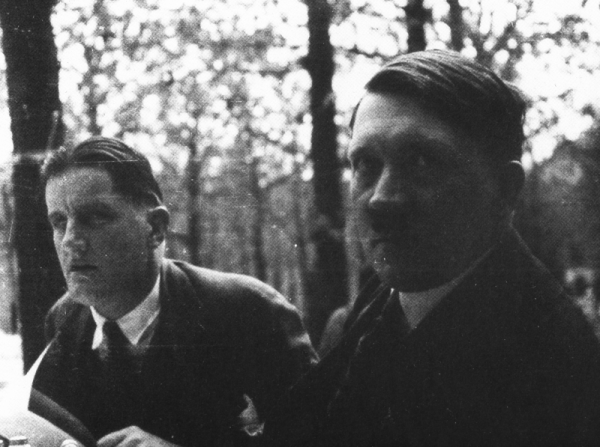VARIAN AND PUTZI: A 20TH CENTURY TALE (Richard Kaplan, 2003-2011)
MoMA Film
Museum of Modern Art
11 West 53rd St. between Fifth & Sixth Aves.
October 8-14
Tickets: $10, in person only, may be applied to museum admission within thirty days, same-day screenings free with museum admission, available at Film and Media Desk
212-708-9400
www.moma.org
 Earlier this year, MoMA presented “Richard Kaplan: Wayfarer and Truth-Teller,” a one-week look at the films of longtime documentarian Richard Kaplan, featuring such works as 1965’s Oscar-winning The Eleanor Roosevelt Story, 1970’s King: A Filmed Record . . . Montgomery to Memphis, 1989’s The Exiles, and 2003’s Varian and Putzi: A 20th-Century Tale. That last film is back at MoMA for its inaugural one-week theatrical premiere, screening October 8-14. The eighty-minute tale follows the parallel stories of two Harvard graduates who had a little-known but significant impact on WWII but met only once. Born in 1887 to an American mother and a German father, Ernst “Putzi” Hanfstängel returned to Germany after college and soon befriended Adolf Hitler, becoming the foreign press chief of the Nazi party before turning his back on the Third Reich and seeking to redeem himself. Meanwhile, journalist Varian Fry, born in New York City in 1907, was one of the first reporters to uncover plans of the Nazis’ Final Solution and formed the Emergency Rescue Committee, which helped hundreds of people, including many famous artists (Marc Chagall, Hannah Arendt, André Masson, Max Ernst, Jacques Lipchitz), out of occupied France and safely into Spain once America wanted nothing to do with him. Kaplan has fascinating footage of Putzi and talks extensively with Putzi’s son, who speaks with remarkable honesty about his conflicted father. Kaplan also speaks with Fry’s widow as well as historians, biographers, and others who knew the two protagonists. One of the stand-outs is Dina Vierney, a model for artist Aristide Maillol who secretly led men and women through the mountains to freedom for Fry and the ERC; telling her story, she bursts with enthusiasm, remembering intricate and intimate details. However, Varian and Putzi suffers from Kaplan’s insistence on using awkwardly colorful backgrounds, silly interstitials of a man lying on a couch in a psychiatrist’s office (as if Fry is confessing to Sigmund Freud), weak narration, and other elements that make it appear as if someone was having fun with one computer design program or another. Still, it’s an engaging tale, and far more satisfying than Lionel Chetwynd’s melodramatic 2001 cable movie, Varian’s War, in which William Hurt starred as Fry. Varian and Putzi shares a pair of essential Holocaust stories that deserve to be more widely known.
Earlier this year, MoMA presented “Richard Kaplan: Wayfarer and Truth-Teller,” a one-week look at the films of longtime documentarian Richard Kaplan, featuring such works as 1965’s Oscar-winning The Eleanor Roosevelt Story, 1970’s King: A Filmed Record . . . Montgomery to Memphis, 1989’s The Exiles, and 2003’s Varian and Putzi: A 20th-Century Tale. That last film is back at MoMA for its inaugural one-week theatrical premiere, screening October 8-14. The eighty-minute tale follows the parallel stories of two Harvard graduates who had a little-known but significant impact on WWII but met only once. Born in 1887 to an American mother and a German father, Ernst “Putzi” Hanfstängel returned to Germany after college and soon befriended Adolf Hitler, becoming the foreign press chief of the Nazi party before turning his back on the Third Reich and seeking to redeem himself. Meanwhile, journalist Varian Fry, born in New York City in 1907, was one of the first reporters to uncover plans of the Nazis’ Final Solution and formed the Emergency Rescue Committee, which helped hundreds of people, including many famous artists (Marc Chagall, Hannah Arendt, André Masson, Max Ernst, Jacques Lipchitz), out of occupied France and safely into Spain once America wanted nothing to do with him. Kaplan has fascinating footage of Putzi and talks extensively with Putzi’s son, who speaks with remarkable honesty about his conflicted father. Kaplan also speaks with Fry’s widow as well as historians, biographers, and others who knew the two protagonists. One of the stand-outs is Dina Vierney, a model for artist Aristide Maillol who secretly led men and women through the mountains to freedom for Fry and the ERC; telling her story, she bursts with enthusiasm, remembering intricate and intimate details. However, Varian and Putzi suffers from Kaplan’s insistence on using awkwardly colorful backgrounds, silly interstitials of a man lying on a couch in a psychiatrist’s office (as if Fry is confessing to Sigmund Freud), weak narration, and other elements that make it appear as if someone was having fun with one computer design program or another. Still, it’s an engaging tale, and far more satisfying than Lionel Chetwynd’s melodramatic 2001 cable movie, Varian’s War, in which William Hurt starred as Fry. Varian and Putzi shares a pair of essential Holocaust stories that deserve to be more widely known.
